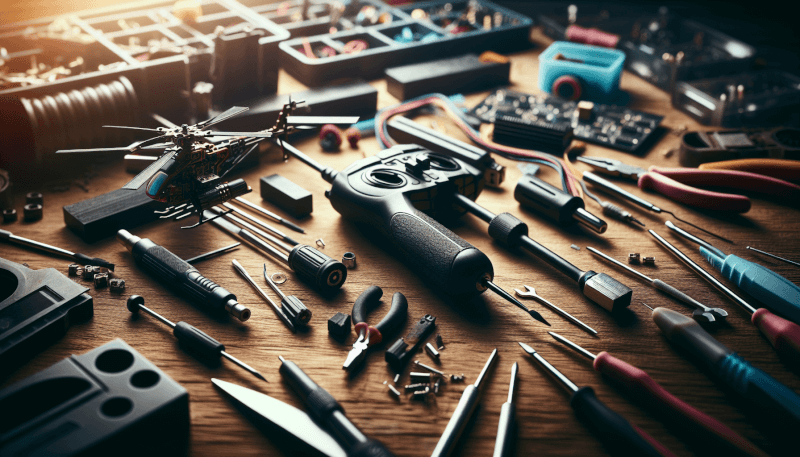Whether you’re a novice or an experienced RC helicopter enthusiast, accidents happen and repairs are inevitable. That’s why having the right tools is essential to keep your RC heli in top-notch condition. From screwdrivers and pliers to soldering irons and wire cutters, this article will guide you through the best tools for DIY RC heli repairs. With these tools by your side, you’ll be able to tackle any repair with ease and get back to the thrill of flying in no time.

Screwdrivers
When it comes to DIY RC heli repairs, having the right tools is essential. One tool that you’ll find yourself reaching for time and time again is a screwdriver. Let’s take a look at three types of screwdrivers that are must-haves for any RC heli enthusiast.
Hex Screwdrivers
Hex screwdrivers, also known as Allen wrenches, are indispensable for working on RC helis. These screwdrivers have a hexagonal-shaped tip that fits into corresponding hexagonal screw heads. They come in different sizes, so it’s important to have a set that covers a range of sizes. Hex screwdrivers provide excellent grip and leverage, making them ideal for loosening or tightening screws with hex heads.
Phillips Screwdrivers
Another essential screwdriver for RC heli repairs is the Phillips screwdriver. This type of screwdriver features a cross-shaped tip that fits into cross-shaped screw heads. Phillips screwdrivers come in various sizes, just like hex screwdrivers, so it’s important to have a set that can handle different screw sizes. These screwdrivers are commonly used in RC helis for tasks such as securing propellers or fastening electronic components.
Flathead Screwdrivers
Flathead screwdrivers are the third type of screwdriver that every RC heli enthusiast should have in their toolbox. These screwdrivers have a flat, narrow tip that fits into slotted screw heads. Flathead screwdrivers are versatile and can be used for a variety of tasks, such as adjusting servo arms or securing battery compartments. Just like the other types of screwdrivers, having a set of different sizes is important to ensure you have the right tool for the job.
Pliers
In addition to screwdrivers, pliers are another must-have tool for DIY RC heli repairs. Pliers are great for gripping, bending, and cutting wires, as well as handling small components. Let’s explore three types of pliers that are essential for working on RC helis.
Needle Nose Pliers
Needle nose pliers are a staple tool for any RC heli enthusiast. These pliers have long, thin jaws that taper to a point, allowing for precise and delicate work. They are ideal for gripping and bending wires, as well as reaching into tight spaces. Needle nose pliers also come in handy for tasks like installing or removing small screws or connectors.
Wire Cutters
Wire cutters are another essential tool for RC heli repairs. As the name suggests, wire cutters are designed to precisely cut wires. They have sharp cutting edges that can cleanly slice through various wire gauges commonly found in RC helis. When choosing wire cutters, it’s important to select a pair that can handle the wire sizes you typically work with and also provide a comfortable grip for extended use.
Locking Pliers
Locking pliers, also known as Vise-Grips, are a versatile tool that can be a game-changer for RC heli repairs. These pliers feature an adjustable locking mechanism that allows them to securely hold objects in place. This is particularly useful when you need to free up your hands to perform other tasks. Locking pliers can grip rounded or irregularly shaped objects, making them ideal for tasks like loosening or tightening nuts, bolts, or ball links.
Wrenches
Another tool category that is essential for DIY RC heli repairs is wrenches. Wrenches provide leverage and allow you to tighten or loosen nuts, bolts, and other fasteners. Let’s delve into three types of wrenches that every RC heli enthusiast should have in their toolkit.
Adjustable Wrenches
Adjustable wrenches, sometimes referred to as crescent wrenches, are a must-have for any RC heli hobbyist. These versatile wrenches have an adjustable jaw that can be customized to fit different sizes of nuts and bolts. The adjustable feature eliminates the need for multiple wrenches, making them a convenient choice. Adjustable wrenches are commonly used in RC heli repairs for tasks such as tightening or loosening landing gear or rotor blades.
Socket Wrenches
Socket wrenches, also known as ratchet wrenches, are the go-to tool for many RC heli enthusiasts. These wrenches feature a removable socket that fits onto a ratcheting mechanism. The socket allows for a secure fit on bolts and nuts of various sizes. Socket wrenches are available in both metric and standard measurements, so it’s essential to have a set that covers the sizes commonly found in RC helis. This type of wrench is ideal for tasks like assembling or disassembling gearboxes or tightening fasteners in hard-to-reach areas.
Open-Ended Wrenches
Open-ended wrenches are another type of wrench that should be part of your RC heli repair toolkit. These wrenches have U-shaped jaws at both ends, with each end fitting a different size of bolt or nut. Open-ended wrenches provide a firm grip, making them suitable for tasks such as adjusting control linkages or tightening servo screws. It’s important to have a set of various sizes to ensure you have the right wrench for the job.
Scissors and Cutters
Besides screwdrivers, pliers, and wrenches, having scissors and cutters on hand is essential when working on RC heli repairs. Scissors and cutters are versatile tools that are useful for various tasks, from cutting and trimming wires to precise cutting of materials. Let’s explore three types of scissors and cutters that are valuable additions to your RC heli repair toolkit.
Precision Scissors
Precision scissors, also known as hobby scissors, are essential for precise cutting and trimming tasks in RC heli repairs. These scissors are typically small and have sharp, fine-tipped blades that can cut through various materials, including wire insulation, heat shrink tubing, and decals. Precision scissors are compact and lightweight, making them easy to maneuver in tight spaces. With their sharp blades and precise cutting capability, these scissors are perfect for trimming excess wire lengths or cutting thin materials with accuracy.
Wire Strippers
Wire strippers are indispensable for any RC heli enthusiast who frequently handles wires. These tools are designed to remove insulation from wires without damaging the conductor underneath. Wire strippers often have multiple-sized cutting notches or a built-in adjustment mechanism to accommodate different wire gauges. Stripping wires accurately is crucial for proper connection and conductivity, making wire strippers an essential tool for RC heli repairs.
Flush Cutters
Flush cutters, also known as side cutters or diagonal cutters, are invaluable for cutting wires, leads, and other materials closer to surfaces. Unlike regular wire cutters, flush cutters have beveled cutting edges that provide a flush cut, leaving minimal or no protruding wire ends. This feature helps prevent snagging or catching on components and ensures a clean and professional finish. Flush cutters are commonly used in RC heli repairs for tasks like trimming excess wire lengths after soldering or cutting zip ties and tape.

Tweezers
Tweezers are small yet incredibly handy tools that are great for handling small components or performing delicate tasks in RC heli repairs. They provide precision and control, enabling you to manipulate small parts with ease. Let’s explore three types of tweezers that are essential for any RC heli enthusiast.
Fine-Tip Tweezers
Fine-tip tweezers, sometimes referred to as precision tweezers, are perfect for picking up and placing tiny components with accuracy. These tweezers have a pointed, narrow tip that allows for precise control and handling of small parts such as screws, washers, or gears. Fine-tip tweezers are particularly useful when working in tight spaces or when dealing with intricate RC heli components that require delicate handling.
Self-Locking Tweezers
Self-locking tweezers, also known as forceps or locking clamps, are invaluable for holding small parts securely in place. Unlike regular tweezers, self-locking tweezers have an adjustable locking mechanism that keeps them closed and securely grips onto objects. This feature is advantageous when you need both hands free to perform other tasks or when working with components that require a firm grip. Self-locking tweezers are often used in RC heli repairs when soldering, gluing small parts, or working with delicate parts that need to be held in place.
Serrated Tweezers
Serrated tweezers are another type of tweezers that are valuable in RC heli repairs. These tweezers have a serrated gripping surface on one or both sides of the tip. The serrated surface provides extra grip and prevents slipping when picking up or handling small parts. Serrated tweezers are particularly useful when dealing with components that have smooth or slippery surfaces, such as tiny connectors or small screws.
Multimeter
A multimeter is an essential tool for any RC heli enthusiast who wants to diagnose electrical issues, measure voltage or resistance, and ensure proper functioning of electronic components. Let’s explore three types of multimeters that are commonly used in RC heli repairs.
Digital Multimeter
Digital multimeters are the most common type of multimeter and offer a wide range of features for RC heli repairs. These multimeters typically have an LCD screen that displays measurements digitally, making them easy to read. Digital multimeters can measure voltage, current, resistance, capacitance, and more. They often come with additional features like continuity and diode testing, making them versatile tools for troubleshooting and testing electronic components in RC helis.
Analog Multimeter
Analog multimeters, also known as analog volt-ohm-milliammeters (VOMs), date back to the early days of electronics. These multimeters use a moving needle or pointer to display measurements. While not as precise or versatile as digital multimeters, analog multimeters are still useful for basic measurements like voltage, resistance, and current. They are often favored by some RC heli enthusiasts due to their simplicity and ease of use.
Auto-Ranging Multimeter
Auto-ranging multimeters are a convenient choice for RC heli enthusiasts who don’t want to manually select the appropriate range for each measurement. These multimeters automatically adjust their measurement range based on the input signal. This feature eliminates the need for manual range selection and reduces the chances of using the wrong range, which could lead to inaccurate measurements. Auto-ranging multimeters often come with additional features similar to digital multimeters, making them versatile tools for RC heli repairs.

Soldering Iron
Soldering is a skill that many RC heli enthusiasts eventually master, as it allows for precise and reliable electrical connections. A soldering iron is a tool used in soldering electronic components together. Let’s explore three types of soldering irons that are commonly used in RC heli repairs.
Temperature-Adjustable Soldering Iron
A temperature-adjustable soldering iron is a versatile tool that allows for precise control over the soldering temperature. Different electronic components and materials require different soldering temperatures for effective solder joints. Having a soldering iron with adjustable temperature settings allows you to match the temperature to the specific requirements of your RC heli repairs. It’s important to choose a soldering iron that can reach and maintain the temperatures needed for the components and materials you commonly work with.
Butane Soldering Iron
A butane soldering iron is a portable and convenient tool for RC heli repairs. Unlike conventional soldering irons that require a power source, a butane soldering iron operates using butane gas. This makes it ideal for repairs on the go or in situations where access to electricity is limited or unavailable. Butane soldering irons often come with adjustable temperature settings, allowing for versatility in various soldering applications.
Mini Soldering Iron
Mini soldering irons, as the name implies, are compact versions of traditional soldering irons. These soldering irons are lightweight and easy to handle, making them perfect for delicate RC heli repairs or soldering in tight spaces. While mini soldering irons may have limited power compared to larger models, they are still capable of creating strong solder joints when used correctly. Mini soldering irons often heat up quickly, allowing for efficient repairs and reducing the waiting time between soldering tasks.
Heat Gun
Heat guns are essential tools for RC heli repairs that involve heat-shrinking tubing, removing adhesives, or applying heat to components. Let’s explore three types of heat guns that are commonly used in RC heli repairs.
Hot Air Gun
A hot air gun is a versatile tool that emits a concentrated stream of hot air. These guns can generate a significant amount of heat and are ideal for tasks like heat-shrinking tubing or removing adhesives. Hot air guns often come with adjustable temperature and airflow settings, allowing for precise control over the amount of heat applied. When working with heat-sensitive components, having a hot air gun that allows precise temperature adjustments is crucial to prevent damage.
Dual Temperature Heat Gun
Dual temperature heat guns, as the name suggests, have two preset temperature settings. These heat guns are typically designed with a high and low temperature setting, making them suitable for different RC heli repair tasks. The lower temperature setting is useful for heat-shrinking tubing or drying adhesives, while the higher temperature setting is ideal for tasks like removing paint or bending plastic components.
Cordless Heat Gun
Cordless heat guns provide the convenience of portability and the freedom to move around without being restricted by a power cord. These heat guns are typically battery-powered, making them ideal for outdoor or on-the-go RC heli repairs. Cordless heat guns often come with adjustable temperature settings and airflow controls, giving you the flexibility to tackle a wide range of repair tasks. It’s important to choose a cordless heat gun with a battery that provides sufficient runtime for your needs, ensuring you can complete repairs without interruption.

Adhesive and Tape
Adhesive and tape play vital roles in RC heli repairs, from securing components to providing insulation. Let’s explore three types of adhesive and tape that are commonly used in RC heli repairs.
Cyanoacrylate Adhesive
Cyanoacrylate adhesive, commonly known as super glue, is a fast-acting adhesive that bonds quickly and securely. This type of adhesive is suitable for a variety of RC heli repairs, from attaching small components to repairing broken parts. Cyanoacrylate adhesive is available in different viscosities, allowing for different application techniques. It’s important to choose a cyanoacrylate adhesive that suits the materials you commonly work with and provides the desired strength and drying time.
Electrical Tape
Electrical tape is an essential component of any RC heli enthusiast’s toolkit. This tape is designed to insulate and protect electrical connections from moisture, short circuits, and other potentially damaging elements. Electrical tape is typically made of vinyl and can withstand a range of temperatures. It comes in various colors and widths, allowing for easy identification and organization of wiring in RC helis. When selecting electrical tape, it’s important to choose one that meets the necessary electrical insulation requirements and provides a secure and long-lasting seal.
Double-Sided Tape
Double-sided tape is a versatile adhesive option for RC heli repairs. This tape has adhesive on both sides, allowing for easy and secure bonding of various materials. Double-sided tape is commonly used in RC helis for applications like attaching small electronic components or securing batteries and other accessories. It comes in different widths and strengths, so it’s important to choose the appropriate tape for the weight and size of the components you are working with. Double-sided tape is an excellent alternative to screws or other mechanical fasteners when you want to maintain a clean and unobtrusive appearance.
Cleaning and Lubrication
Cleaning and lubricating your RC heli is crucial for maintaining its performance and prolonging its lifespan. Let’s explore three types of cleaning and lubrication products that are essential for RC heli maintenance.
Contact Cleaner
Contact cleaner is a specialized cleaning product designed to remove dirt, dust, and other contaminants from electrical contacts and connectors. In RC helis, contact cleaner is valuable for cleaning servo connectors, battery connectors, and other electrical connections. It helps ensure a reliable electrical connection and prevents problems like intermittent signals or poor conductivity. It’s important to choose a contact cleaner that is safe for use on electronics and leaves no residue behind.
Silicone Lubricants
Silicone lubricants are commonly used in RC heli maintenance to reduce friction and provide long-lasting lubrication. These lubricants are ideal for lubricating moving parts such as gears, bearings, and linkages. Silicone lubricants offer excellent temperature resistance, which is important for RC helis that operate in a wide range of temperatures. When applying silicone lubricants, it’s crucial to use them sparingly to avoid excess buildup that can attract dirt or interfere with sensitive components.
Compressed Air Duster
A compressed air duster is a handy tool for removing dust, debris, and other contaminants from hard-to-reach areas of your RC heli. It works by blowing a concentrated stream of compressed air, dislodging dirt and particles from crevices and components. Compressed air dusters are useful for cleaning electronics, cooling fins, and other sensitive parts of your RC heli. When using compressed air dusters, it’s important to hold the canister upright and follow the manufacturer’s instructions to ensure safe and effective use.
In conclusion, having the right tools for DIY RC heli repairs is essential for any RC heli enthusiast. Screwdrivers, pliers, wrenches, scissors and cutters, tweezers, multimeters, soldering irons, heat guns, adhesives and tape, and cleaning and lubrication products are all important tools to have in your toolkit. By equipping yourself with these tools, you’ll be ready to tackle a wide range of RC heli repairs with confidence and precision. Remember to always follow safety precautions and refer to manufacturer guidelines when using your tools to ensure safe and successful repairs. Happy repairing!



